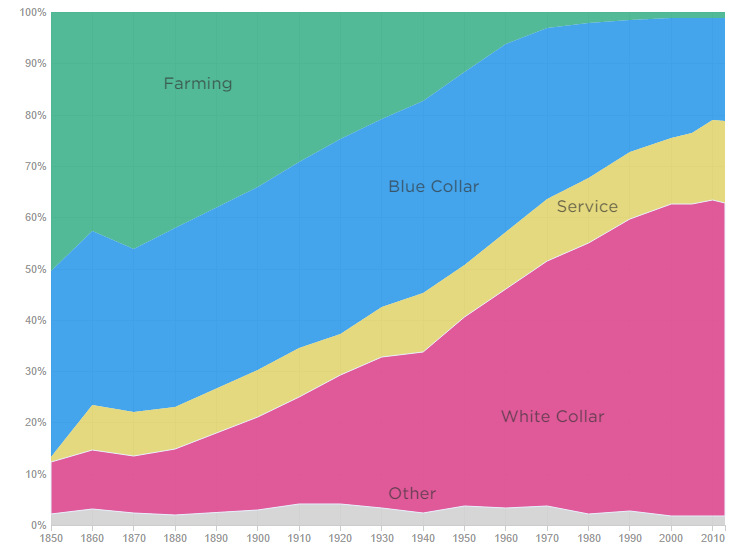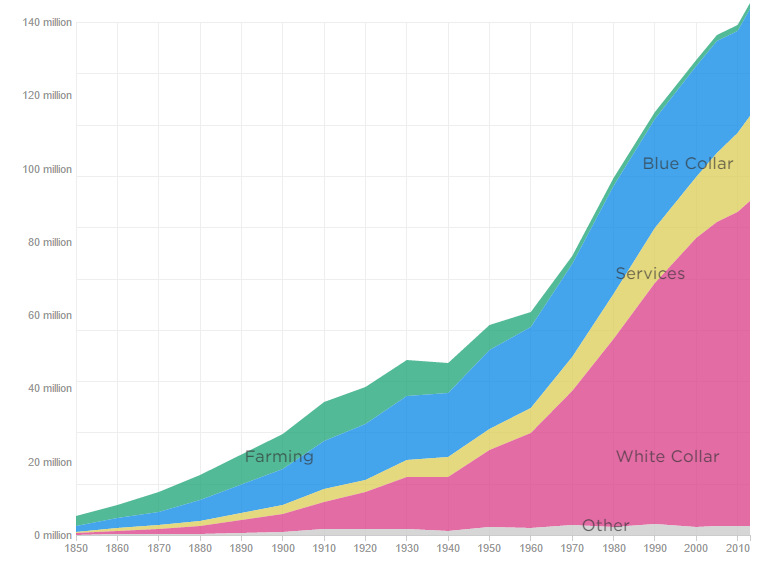Technology
How Machines Destroy and Create Jobs
“There’s just doesn’t seem to be many blacksmith jobs these days.”
At first glance, this would be a ridiculous thing to say. Of course there aren’t many blacksmiths around. We live in a modern society and machines do a way better job of making things from metal anyways.
However, it also raises an important point.
What if machines are better at driving long-haul trucks? What if machines are better servers at McDonald’s? What if robots did your taxes for you?
While some of these ideas are contentious today, in the future we may look back thinking that our fears were ill-placed. The truth is that the job landscape is constantly in flux as technology changes.
Some of today’s jobs with high automation potential may be the future “blacksmiths”, and we should not be surprised if they go away. The best thing that we can do is to understand these trends and build a set of skills that will be in demand in any market.
The Trend is Your Friend
The following graphics from NPR shows the evolution of jobs over time in the United States.
The first divides jobs into four main categories: white collar, blue collar, farming, and services. It shows how the composition of the overall job market has changed over the last 165 years:

The second shows the same information, but plotted by the total number of jobs:

There were 10 million farmers in America in the early 20th century.
Now there’s closer to one million, and yet those farmers produce way more food. Technology may have “killed off” the majority of farm jobs, but at the same time new technology created jobs in the service, blue collar, and white collar industries.
We may now be at a similar inflection point for other careers – this interactive graphic shows some of the jobs that have been on the decline in recent years.
In 1960, a whopping 11% of the workforce was employed in factories. Today only 4% are employed in factories.
In the late 1970s, almost 5% of the workforce was secretaries. Today, we’re at about half that, but professionals can be just as productive without a secretary thanks to better computer software.
Yes, there are globalization issues at play here as well, but even a modern domestic factory such as the Tesla Gigafactory (which has the largest building by footprint in the world) will only employ about 6,000 people. The majority of the work will be done by robots.
And while it seems scary to think about the rise of machines and a faster pace of technological advancement, it’s important to recognize that these types of sweeping changes to the job market have happened throughout history.
The point is, try not to be the 21st century version of a “blacksmith”.
Brands
How Tech Logos Have Evolved Over Time
From complete overhauls to more subtle tweaks, these tech logos have had quite a journey. Featuring: Google, Apple, and more.

How Tech Logos Have Evolved Over Time
This was originally posted on our Voronoi app. Download the app for free on iOS or Android and discover incredible data-driven charts from a variety of trusted sources.
One would be hard-pressed to find a company that has never changed its logo. Granted, some brands—like Rolex, IBM, and Coca-Cola—tend to just have more minimalistic updates. But other companies undergo an entire identity change, thus necessitating a full overhaul.
In this graphic, we visualized the evolution of prominent tech companies’ logos over time. All of these brands ranked highly in a Q1 2024 YouGov study of America’s most famous tech brands. The logo changes are sourced from 1000logos.net.
How Many Times Has Google Changed Its Logo?
Google and Facebook share a 98% fame rating according to YouGov. But while Facebook’s rise was captured in The Social Network (2010), Google’s history tends to be a little less lionized in popular culture.
For example, Google was initially called “Backrub” because it analyzed “back links” to understand how important a website was. Since its founding, Google has undergone eight logo changes, finally settling on its current one in 2015.
| Company | Number of Logo Changes |
|---|---|
| 8 | |
| HP | 8 |
| Amazon | 6 |
| Microsoft | 6 |
| Samsung | 6 |
| Apple | 5* |
Note: *Includes color changes. Source: 1000Logos.net
Another fun origin story is Microsoft, which started off as Traf-O-Data, a traffic counter reading company that generated reports for traffic engineers. By 1975, the company was renamed. But it wasn’t until 2012 that Microsoft put the iconic Windows logo—still the most popular desktop operating system—alongside its name.
And then there’s Samsung, which started as a grocery trading store in 1938. Its pivot to electronics started in the 1970s with black and white television sets. For 55 years, the company kept some form of stars from its first logo, until 1993, when the iconic encircled blue Samsung logo debuted.
Finally, Apple’s first logo in 1976 featured Isaac Newton reading under a tree—moments before an apple fell on his head. Two years later, the iconic bitten apple logo would be designed at Steve Jobs’ behest, and it would take another two decades for it to go monochrome.
-

 Travel1 week ago
Travel1 week agoAirline Incidents: How Do Boeing and Airbus Compare?
-

 Markets3 weeks ago
Markets3 weeks agoVisualizing America’s Shortage of Affordable Homes
-

 Green2 weeks ago
Green2 weeks agoRanked: Top Countries by Total Forest Loss Since 2001
-

 Money2 weeks ago
Money2 weeks agoWhere Does One U.S. Tax Dollar Go?
-

 Misc2 weeks ago
Misc2 weeks agoAlmost Every EV Stock is Down After Q1 2024
-

 AI2 weeks ago
AI2 weeks agoThe Stock Performance of U.S. Chipmakers So Far in 2024
-

 Markets2 weeks ago
Markets2 weeks agoCharted: Big Four Market Share by S&P 500 Audits
-

 Real Estate2 weeks ago
Real Estate2 weeks agoRanked: The Most Valuable Housing Markets in America














